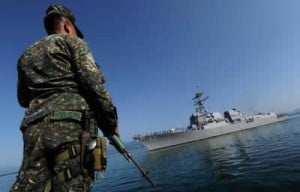 “The United States has always been a Pacific power because of our very great blessing of geography. And India straddling the waters from the Indian to the Pacific Ocean is, with us, a steward of these waterways. We are both deeply invested in shaping the future of the region that they connect. And there are big questions for us to consider. Will this region adopt basic rules of the road or rules of the sea to mobilize strategic and economic cooperation and manage disagreements? Will it build the regional architecture of institutions and arrangements to enforce international norms on security, trade, rule of law, human rights, and accountable governance? Through its Look East policy, India is poised to help lead toward the answers to these questions.”
“The United States has always been a Pacific power because of our very great blessing of geography. And India straddling the waters from the Indian to the Pacific Ocean is, with us, a steward of these waterways. We are both deeply invested in shaping the future of the region that they connect. And there are big questions for us to consider. Will this region adopt basic rules of the road or rules of the sea to mobilize strategic and economic cooperation and manage disagreements? Will it build the regional architecture of institutions and arrangements to enforce international norms on security, trade, rule of law, human rights, and accountable governance? Through its Look East policy, India is poised to help lead toward the answers to these questions.”
So spoke Secretary of State Hillary Clinton during a recent speech in Chennai, where she is participating in a strategic dialogue with her Indian counterparts before attending the upcoming APEC summit which will convene on July 23rd.
Two things in particular strike me about the above passage.
The first is that the one need look no further than the waterways of East Asia to find one of the most confounding variables of international security in the East Asia. As a slew of commentary on China’s increasingly vigorous presence in the seaways of the South China Sea have made clear, access to and management of sea lanes in this region in particular comprises one of the most pressing tensions in a region that is undergoing a multitude of considerable geopolitical shifts. Put another way, if there is a playing field for international politics in East Asia, it is its waterways. It has been this way for well over a century: control of the Pacific Ocean has long served as a linchpin issue for the rise and fall of great powers in the region. It remains to be seen how China’s rise (and the attendant changes to its maritime policies) will re-configure the logic and political geography of the Pacific, but it can be said with great certainty that these changes will not happen quietly.
It is far from surprising that American diplomats would take this opportunity to build solidarity behind this issue in particular, as it will likely consume tremendous diplomatic energy and resources in the future. Of course, the US will have to reach out well beyond its Indian partners to manage this issue and build the support it needs to remain “a steward of the waterways,” but India is doubtless a key stakeholder in this issue. I suspect that this will be a highly prioritized item on the docket of the trilateral US-Japan-India on the sidelines of APEC. The not-so-distant Senkaku Incident in particular and subsequent adjustments to Japan’s defense policy more generally seem to indicate a shift, if a slight one, towards a more nimble, forward-deploying naval posture in its surrounding seas.
The second point follows from the first. Much ink has been spilled about the existence and usefulness of the notion of the “arc of democracy” in the Asia-Pacific: that is, a set of shared values, political understandings, and historical partnerships between the US, Japan, and India (and, these days, other partners including Indonesia). The trilateral summit surely highlights the importance of this bloc to the region. But what concrete progress has been forged in recent years between these parties, especially after the shifts in the political winds of 2008 in the US and 2009 in Japan? Very little. Though diplomats continue to wax enthusiastic about the importance of these partnerships few concrete takeaways have been forged in the last three years — a point made powerfully by Michael Green and Daniel Twining in a recent op-ed. The crux of their assessment boils down to this: “mixed U.S. messaging about ‘strategic restraint’ and ‘strategic reassurance’ toward our competitors encourages India and Japan to pursue self-help strategies premised on a belief that Washington’s determination to defend common interests is wanting. The tone of our relationships is set in Washington as well as in Tokyo and New Delhi.”
Which is precisely why this upcoming trilateral should be closely scrutinized. Recent developments in the region call for a frank and lengthy discussion of the future of this strategic dialogue.